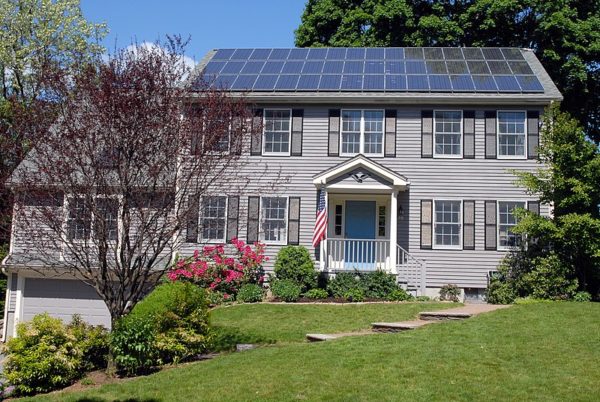Massachusetts has numerous programs supporting the buildout of clean energy in intelligent ways that adapt to the rapid evolution of technology. It is home to several prestigious universities that are at the forefront of research combatting climate change and improving science-based approaches to a more sustainable future.
The state houses many innovative companies working on the problem, and hosts Greentown Labs, a hub for cleantech startups and researchers, which, along with its 2021-established chapter in Houston, hosts over 180 startups targeting human sustainability.
The state was also instrumental in the 2007 landmark case Massachusetts vs. EPA, which opened the door for states to have standing to sue based on climate-related damages. It also required EPA to determine if human-emitted greenhouse gases led to climate-related harm, and if so, established that EPA must regulate those emissions.
Solar in Massachusetts
Solar PV is a big part of Massachusetts climate and energy goals. It is ranked as a top-10 solar state by the Solar Energy Industries Association (SEIA), with over 3.6 GW installed through 2021, and over 400 businesses in the industry. This ranking is impressive considering it ranks 16 in population, has limited open land availability, and is in the lower half of the nation in terms of solar irradiance.
It has a wide mix of projects across sectors, particularly making significant gains in residential, commercial, and community solar.
Incentives and programs
Massachusetts is a leader in incentive design in the nation. On the Database of State Incentives for Renewables (DSIRE) it has 114 distinct incentive programs listed.
One of the most significant incentives for the state in recent years is Solar Massachusetts Renewable Target (SMART) program. The program is capped at an aggregate 1.6 GW of deployment and provides per-kWh incentives for PV projects 5 MW or less. About 20-35% of the allotted capacity is designed for projects 25 kW or less, essentially a residential solar carve-out.
The SMART program works on a declining-block program in 80 MW blocks, meaning that earlier projects will be more heavily incentivized, and as the program passes through the blocks, incentive values will drop by 4% per block.
The calculation for the SMART program incentives is complex, designed intelligently to steer the profile of projects in the state toward goals of energy equity, distributed generation, energy storage, and reliability. It integrates value adders for projects based on size, income levels, technologies used including energy storage, and more. A spreadsheet to calculate SMART program incentives can be found here.
Net metering, another essential policy for residential and commercial solar projects, is alive and well in Massachusetts, though there are some limitations. Projects of 60 kW or less are credited a full 100% value for their excess solar generation, and projects ranging from 60-2,000 kW are paid 60% of the retail rate of energy, as determined by Massachusetts law.
There are capacity caps to net metering in Massachusetts, suggesting that projects installed in the future may receive lower payments unless the state replenishes the program. More details on net metering can be found here.
The state provides a personal income tax credit of up to $1,000 of 15% of qualified project costs, whichever is less.
Community solar programs have steadily been on the rise in Massachusetts in recent years. A comprehensive guide run by the state’s Clean Energy Center can be found here.
Landmark project
A breakthrough project in the state that may serve as a model for the evolving, distributed energy grid would be Sunrun’s contract to participate in the ISO New England wholesale capacity market. In a first-of-its-kind project, Sunrun was granted the ability to aggregate 20 MW of energy capacity across its solar and energy storage customers, selling power on the wholesale market.

As part of the bid, Sunrun will deploy distributed solar and battery storage to about 5,000 customers in Massachusetts. It will be required to offer the grid 20 MW of power, 24 hours a day for the one-year period. In return, Sunrun will be paid $3.80/kW/month, representing a $912,000 total contract value. Homeowners who signed up for the program agree to allow their battery to be discharged overnight. In exchange, they receive an upfront cash incentive as either a payment or a reduction in the upfront cost of their system.
This kind of project may be a signal for how energy is managed in the future. There are many benefits to installing solar and energy storage in a distributed fashion, and those grid/societal benefits are amplified when resources are pooled and dispatched intelligently.
A study run by New Zealand’s University of Otago found the collective use of batteries across several neighborhoods had dramatic effects on both load smoothing and peak demand shaving. Aggregation of smart storage led to a reduction in per-house battery requirements by 50% for load-smoothing needs and by 90% for peak shaving. As an example, if peak shaving occurred for demand above 3 kW per house, deploying batteries individually for 20 houses would require 120 kWh of storage. By contrast, deploying batteries collectively would only require 7 kWh, the researchers said.
Looking ahead
Massachusetts has set sector-specific goals, with targets every five years to stay on track, to reduce carbon emissions across the economy. By 2050, the state aims for an 85% reduction of emissions below 1990 levels. This upcoming July, the state has set a deadline for adopting 2025 and 2030 emissions limit and mandates the creation of a comprehensive plant to achieve those limits. A presentation on the development of those plans can be found here.
Last time, we reviewed the solar incentive profile of Massachusetts’ northern neighbor, New Hampshire, a state with differing philosophies and much more limited support of solar buildout. Our next stop on the 50 states of solar incentives tour will take us south to the neighboring state of Rhode Island.


